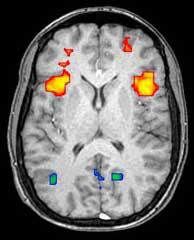
EuroBuzz News: Day 1
EuroBuzz news: Day 1. Ed and Jeff reporting from the European Huntington’s Disease Network meeting in Stockholm

Our first daily report from the European Huntington’s Disease Network Meeting in Stockholm. Follow us live for the second day on Twitter or Facebook at HDBuzzFeed. Video of the day’s live Euro Buzz session – with news, interviews and features – will be available to watch on HDBuzz.net soon.
Friday, September 14, 2012
8:11 – Welcome to EuroBuzz 2012, Ed Wild & Jeff Carroll reporting live from the Euro Huntington’s Disease Network meeting in Stockholm.

8:43 – Ed: Paralympian & Deputy Mayor of Gothenburg David Lega welcomes Euro Huntington’s Disease Network to Stockholm.
8:48 – Jeff: Beautiful thoughts to start the meeting from David Lega – athlete, businessman and disability activist. He says “I will always be disabled, but not only disabled.”
9:12 – Ed: Michael Hayden (Univ of British Columbia): as many as 1 in 1000 people may have 50% or 25% risk of Huntington’s disease. The risk of carrying an “intermediate” or “gray area” Huntington’s disease gene may be 5% in general population.
9:22 – Jeff: Michael Hayden (UBC) says that HD is more common than previously thought – as high as 15/100,000. Even more surprisingly, this means that 1/1,000 have a parent or grandparent with HD.
9:45 – Jeff: Cristina Sampaio, Chief Clinical Officer at CHDI Foundation Inc., asks the question – what kind of trails should we run? She advocates for smaller, more flexible trials in hopes of testing drugs more quickly. Her organization is doing a lot of preparatory work to prepare the ground for these new trials.
9:50 – Ed: Cristina Sampaio, former European Medicine Agency head, encourages realistic thinking about how HD treatments may emerge. Many exciting drugs and approaches are in or near trials right now. Future Huntington’s disease drugs may be preventative, disease-modifying or symptomatic – or a combination. Future Huntington’s disease clinical trials need to be smarter designed, smaller and more accurate.
10:25 – Ed: Alexandra Durr (Paris) says the earlier we can treat HD, the better. That means we need to detect the earliest changes. Huntington’s disease gene carriers can cope with a surprising amount of brain shrinkage without getting symptoms.
10:32 – Jeff: The group of Alexandra Durr has been studying people carrying the HD mutation and found that they learn differently – even before they have HD. In the lab, they responded worse to punishment and better to reward type learning. One more reason to be nice!
11:23 – Ed: Hugo Aguilaniu (Lyon, France) asks what genes that control aging might tell us about Huntington’s disease. Worms with certain genetic mutations live much longer than normal. Could this shed light on increasing the health of cells in HD?
11:55 – Ed: Włodz Krzyzosiak – the RNA ‘message’ molecule of some genetic diseases is sometimes harmful- not only proteins. Studying RNA message molecules, as well as DNA & proteins, could help understand and treat diseases like Huntington’s.
12:19 – Jeff: Ray Truant, of McMaster University, wants to understand what the gene that causes HD normally does. Surprisingly, this is still a bit of a mystery.
12:20 – Ed: Ray Truant (Canada) – Huntingtin protein causes HD, but what does it do? The normal huntingtin protein does lots of different things in our cells. It’s one of the biggest proteins we have. Huntingtin protein has lots of parts that are like a ‘slinky’ or spring. Could compression or stretching of huntingtin be important? Huntingtin also moves around from one part of the cell to another. Chemical ‘tags’ or ‘labels’ control its movement. The mutant protein ends up with too many ‘phospho’ tags. That may cause it to build up in the nucleus of our cells. One of the things the huntingtin protein is involved in is responding to physical and chemical stress. Fascinating stuff.
12:36 – Ed: We really need to understand the normal and mutant huntingtin protein if we’re going to beat HD. Truant’s work is really important
12:38 – Jeff & Ed are interviewing Truant & other top Huntington’s scientists on stage at 6pm CET. Video online later on HDBuzz.net
12:39 – Ed: Truant tells us huntingtin protein bends back on itself to form a hairpin. The expanded ‘CAG’ that causes Huntington’s disease alters this. Drug molecules can change how many phospho tags are added to the huntingtin protein, altering its folding & movement in cells. Truant calls his idea ‘rusty hinge’ hypothesis – HD mutation reduces flexibility, prevents huntingtin from helping cell respond to stress. Truant asks an interesting question: is huntingtin protein involved in other neurodegenerative diseases like Alzheimer’s, Parkinson’s & ALS?

12:50 – Ed: Time for lunch here in Stockholm. More updates later. Big audience of scientists & clinicians
14:00 – Ed: We’re back! Juliana Bronzova is discussing Euro-HD Network’s scientific strategy for fighting Huntington’s disease. EHDN coordinates and supports all aspects of Huntington’s disease research including clinical trial support
14:17 – Ed: Oliver Quarrell (Sheffield, UK) gives update on the Juvenile Huntington’s disease Working Group – about one in 20 HD patients gets symptoms before age of 20 – this is juvenile HD and it hasn’t been studied closely enough
14:19 – Ed: A new branch of EHDN’s Registry study is enrolling juvenile HD patients in Europe. 40 JHD people enrolled so far!
14:20 – Ed: Quarrell says Juvenile HD cases start earlier but do they progress more rapidly? And could this be used to test drugs more quickly? At the moment we don’t know whether juvenile HD progresses more rapidly but it’s being studied using brain scans. Juvenile HD usually have large ‘CAG repeat lengths’. Preliminary MRI scans show bigger repeats cause more rapid brain shrinkage. The traditional way of assessing HD isn’t great for young patients with JHD. #EHDN JHD group is testing new scales & questionnaires.
14:27 – Ed: Katia Youssov giving an update on the ‘advanced stage Huntington’s Disease’ working group of EHDN. The main focus of the Advanced HD group is promoting better care. A guidance booklet is being worked on. Like juvenile HD, patients with advanced symptoms are failed by existing ways of measuring the disease symptoms, making trials hard. The EHDN Advanced HD group has developed a new rating scale, the UHDRS-FAP, for supporting clinical trials in later disease
14:39 – Ed: Simon Brooks (Cardiff, UK) studies the effect of exercise programs in HD mice, mimicking physiotherapy in humans. An HD mice can run 5km in a night! Some types of exercise in mice more beneficial than others. When mice run lots on a wheel, they get quicker and more active. The most striking effects of exercise in HD mice are on thinking speed. Mice that exercise also have less brain shrinkage.
14:51 – Ed: Monica Busse (Cardiff, UK) leads the EHDN physiotherapy group studying best physio methods for Huntington’s disease. EHDN physio group is developing an evidence-based home exercise DVD called “Move to Exercise” for people with Huntington’s disease. EHDN physio group is running several other community and gym-based exercise studies to find best way of staying active in HD.
15:14 – Ed: Mike Orth (Ulm, Germany) studies brain activity in people with the Huntington’s disease mutation . HD mutation carrier brains show different amounts of activity at rest, and interestingly increased connections between areas. Mike Orth is one of the scientists we’ll be interviewing later on – videos will be available soon after.
15:20 – Jeff: Michael Orth, a neurologist at the University of Ulm, studies changes in the “default mode network” of the brain. These are the parts of the brain that are active when we’re “idling” or “daydreaming” and not thinking about something specific. When we focus on something specific, these brain regions usually calm down. In the brains of HD mutation carriers, this quieting is incomplete, for reasons that are not yet clear. Scientists like Michael Orth use a technique called “functional magnetic resonance imaging”, or fMRI, to study which parts of the brain are active at a given time.
15:27 – Ed: Nellie Georgiou-Karistianis (Australia) is talking about brain activity too. Dr G-K uses thinking tests in a functional MRI scanner to challenge and probe brain function in Huntington’s disease mutation carriers. She is using fMRI repeatedly over time, we can see what changes in HD and what we can measure, and aim to save with treatments.
15:35 – Ed: Ellen ‘t Hart (Leiden, Netherlands) has been studying patients with different patterns of motor symptoms in HD. Some HD ppl have lots of chorea (extra movements); others have more stiffness. Do thinking changes follow movement problems?. She used EHDN registry study data to identify ‘fidgety’ and ‘stiff’ patients and looked at thinking abilities in the two groups. ‘Fidgety’ patients tended to have better thinking and functional abilities than patients for whom stiffness was main problem.
17:09 – Jeff: Patrik Brundin, of the Van Andel Institute, is providing the meeting with a review of efforts to use ‘stem cells’ to repair damage in the brain of HD animal models and patients.
17:12 – Ed: Patrick Brundin (Van Andel Institute): Trials of fetal cell grafts are still being worked on, alongside stem cell treatments.
Learn more
For more information about our disclosure policy see our FAQ…


